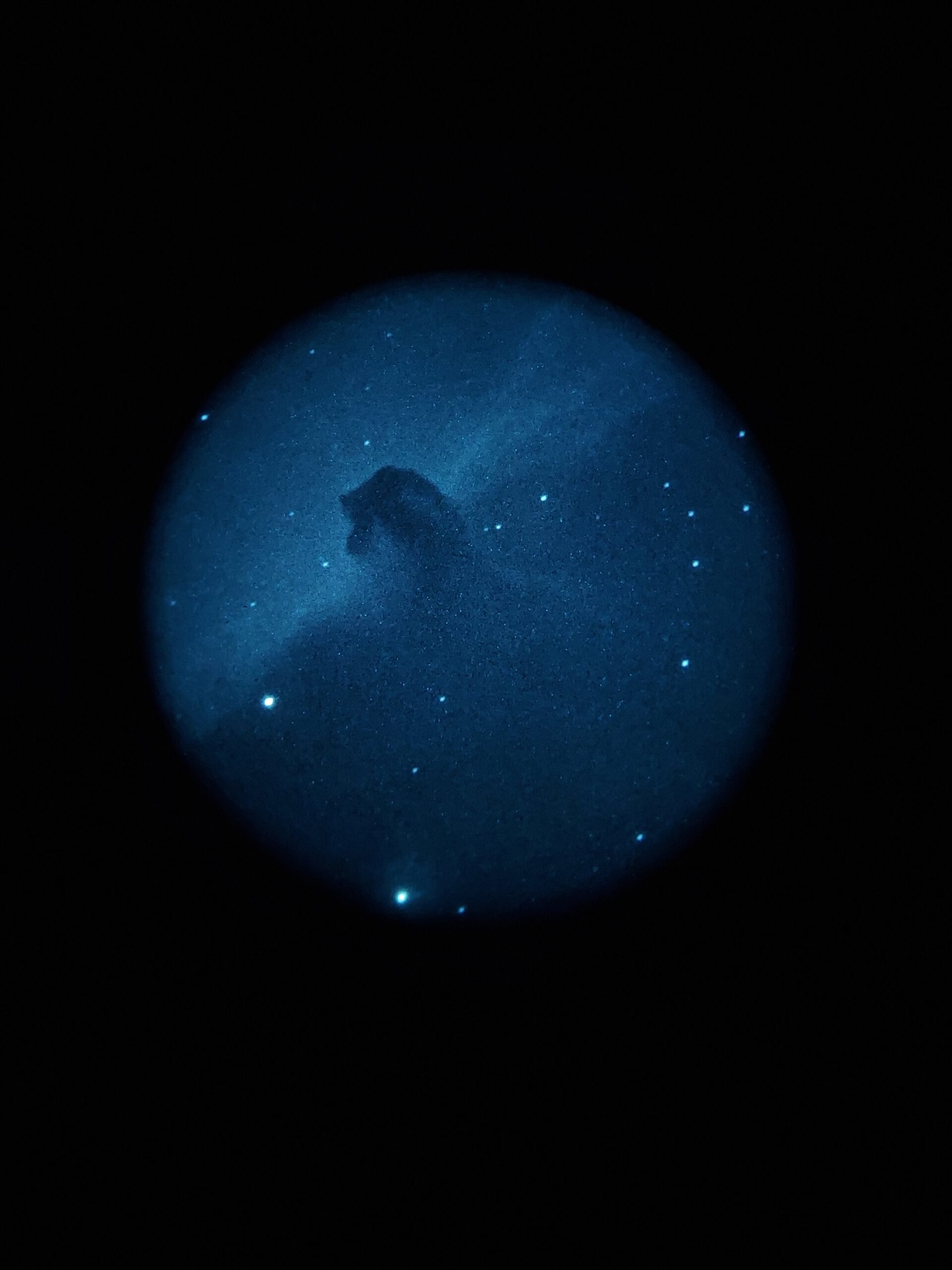Clear winter nights have a magical quality about them. The nights are calm and still, the air cold and crisp, carrying the essence of woodsmoke. The stars appear unusually bright against a dark velvet background. Orion the Hunter towers overhead, monolithic in its strange hourglass geometry. Brilliant Sirius scintillates over the horizon. The Gemini twins; the Pleiades and Hyades.
So many sights which beg for a telescope.
But then there’s the cold. The high-pressure systems which drive away the clouds in winter also tend to bring frigid arctic air with them.
Cold air drains batteries, frosts eyepieces, and makes metal telescope parts painful to handle. Depending on where you live, you might also have piles of snow to contend with.
For all these reasons, many tend to take a pass on winter stargazing.
If it isn’t quite winter where you are, we have a fall list too.
Five good reasons to get out and experience the night sky in winter.
But first, a few tips:
- Dress appropriately; gloves, extra socks, and long johns are recommended. Electric socks are a nice luxury.
- Use a dew heater if you have one; if not, keep all glass covered when not in use.
- When bringing your gear back inside from the cold, let it warm up gradually to avoid condensation, or if that’s not possible, remove lens caps and let the glass dry before storing your gear.
With that out of the way, here are some of my favourite objects to view between January and March.
5 Beautiful Object to Observe in Winter
Sirius
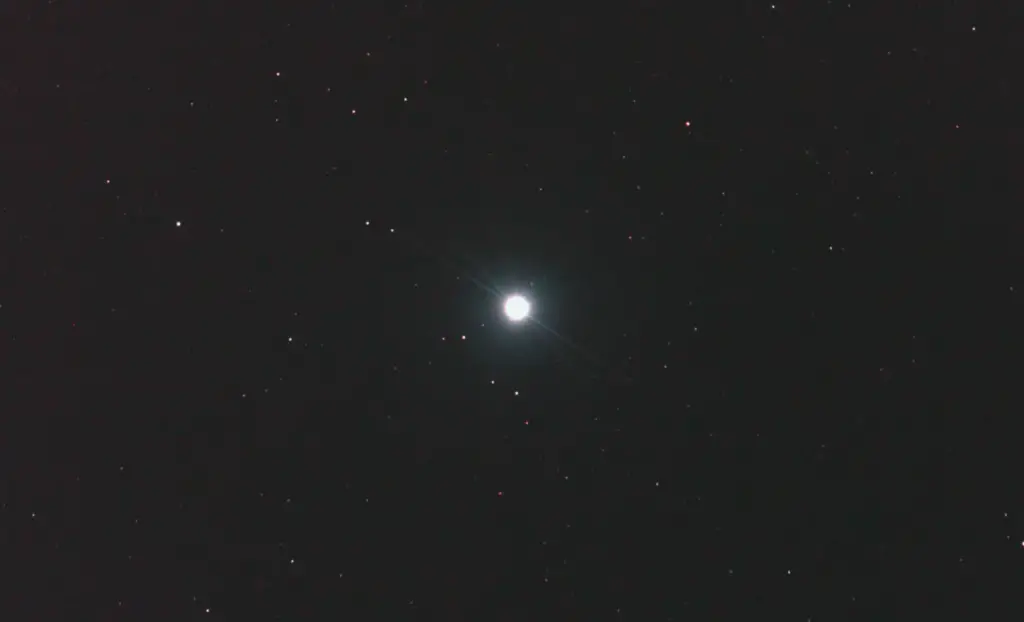
Catalogue #: Alpha Canis Majoris
Object Type: Binary star
Distance: 8.6 light years
Recommended equipment: naked eyes, binoculars, telescope
What it is:
Known as the Dog Star for being at the head of the Canis Major constellation, Sirius is the brightest star visible from Earth.
While technically a binary system, its companion star is hundreds of times fainter than the dazzling primary and not easy to pick out.
At a distance of roughly 82 trillion kilometres, Sirius is practically next door to the sun, which partly explains why it is so bright. It is also about twice as massive as the sun.
How to find it:
Simply look to the lower left (south) of Orion. You can’t miss it.
What to expect:
Even without optical aid, Sirius is an impressive sight, blazing blue-white against a dark winter sky.
Incidentally, the sky appears darker and stars brighter in winter not due to the cold air being more transparent as people often suppose. Rather, it is because of Earth’s orientation relative to the galactic disk in winter.
During the warmer months we look into the galactic disk, with its myriad stars, gas, and interstellar dust, but in winter we gaze out into intergalactic space.
Sirius is a wonderful sight in a telescope. While it won’t show any detail, it’s brilliant bluish hue will become more apparent.
If you are using a Newtonian reflector, you might also see diffraction spikes where the point-source light from the star is split by the secondary mirror supports.
Just for fun, try de-focusing the image until the star becomes a disk. This will enhance the twinkling effect of Earth’s atmosphere on the bright starlight and turn it into a disco ball.
Beehive Cluster
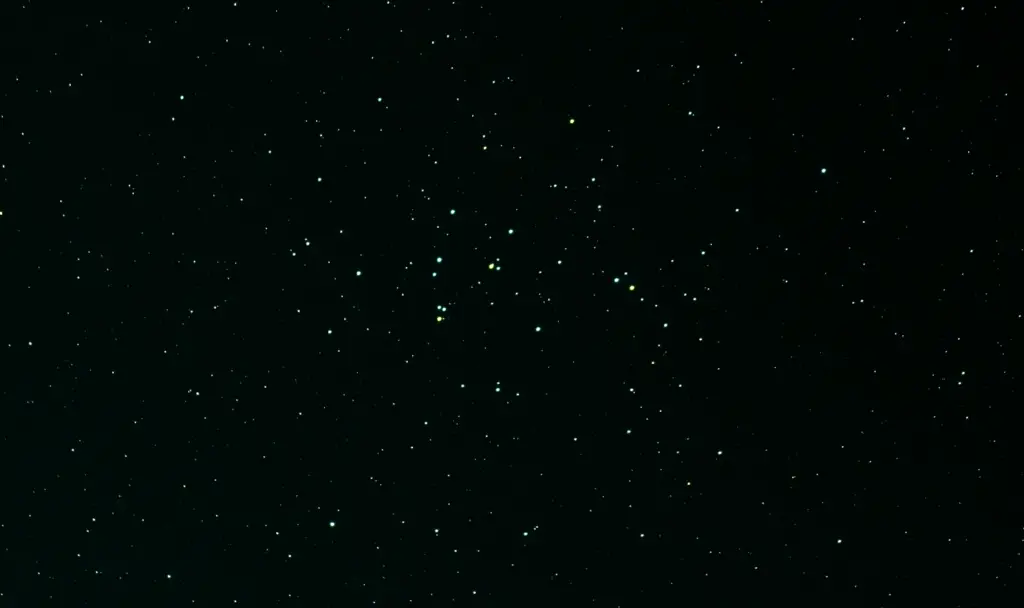
Catalogue #: M44
Object type: Open cluster
Distance: 600 light years
Recommended equipment: binoculars, small telescope
What it is:
The Beehive is a loose open cluster of stars in the constellation Cancer. Though it appears to contain a few dozen stars, this stellar family has at least 1000 known members, including a couple of confirmed planets.
How to find it: Cancer is a rather small, dim constellation with no obvious landmark stars, so I start at Gemini.
Drawing an imaginary line southeast about ten degrees through Castor and Pollux in Gemini will put you in the vicinity, and you should see the Beehive through your binoculars or finderscope.
What to expect:
Binoculars will reveal a small but striking patch of bright stars against a dark winter sky. Through a small telescope at medium power your field of view will be filled with bright bluish stars, with fainter stars peppering the background sky.
If you like, try to imagine “hot Jupiter” planets whizzing around sunlike stars in this cluster. Such planets are unusual to find in open clusters, orbiting sunlike stars with periods of just a few days.
Orion Nebula
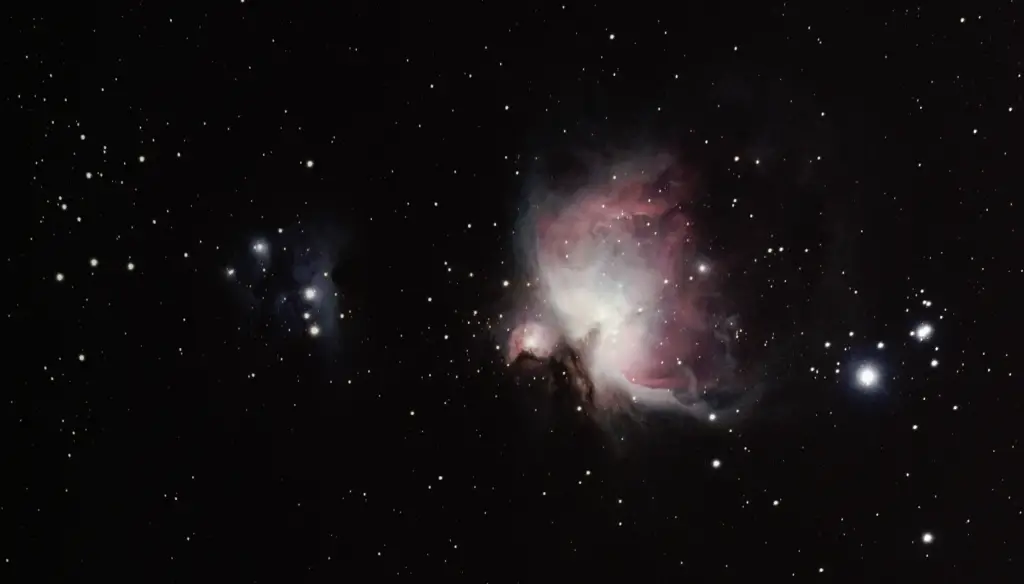
Catalogue #: M42
Object type: Diffuse nebula
Distance: 1300 light years
Recommended equipment: binoculars, telescope
What it is:
One of the most widely photographed deep-sky objects, M42 is a vast starbirth region containing three types of nebulae.
The pinkish regions indicate hydrogen gas which has been excited by ultraviolet radiation of young stars (emission nebula); the blue parts are caused by starlight reflecting off interstellar dust (reflection nebula); and the grey/black regions are where foreground dust has obscured the emission nebula in the background (dark nebula).
This whole gigantic complex covers a radius of around 12 light years and is being shaped by the stellar winds from the stars being formed in its centre, which are gradually blowing the nebula apart.
How to find it:
This is a fun one to locate. Start by getting a visual on the Orion constellation.
Next, locate Orion’s Belt, a three-star asterism bisecting the constellation widthwise.
Below the belt you will find Orion’s Sword, another three stars pointing down with respect to the belt. You might notice that the middle star of the Sword looks a little blurry; this is M42.
What to expect:
M42 is a sight to behold at any magnification. Its wispy structure is apparent even in binoculars.
Through a telescope it is a delicate, cosmic flower, blossoming to reveal a tight cluster of stars known as the Trapezium.
The larger your aperture and the darker your skies, the more detail you’re likely to see. M42 is bright enough to allow for high magnification. With an 8-inch reflector, I’ve viewed it at 389x and seen remarkable detail from the balcony of my old apartment in the suburbs.
Note that you will not see the pink and blue colours visible in photographs. To me, M42 appears distinctly greenish-grey. Most striking is the dark cavity where stellar winds are carving a hollow out of the giant molecular cloud.
Bode’s Galaxy
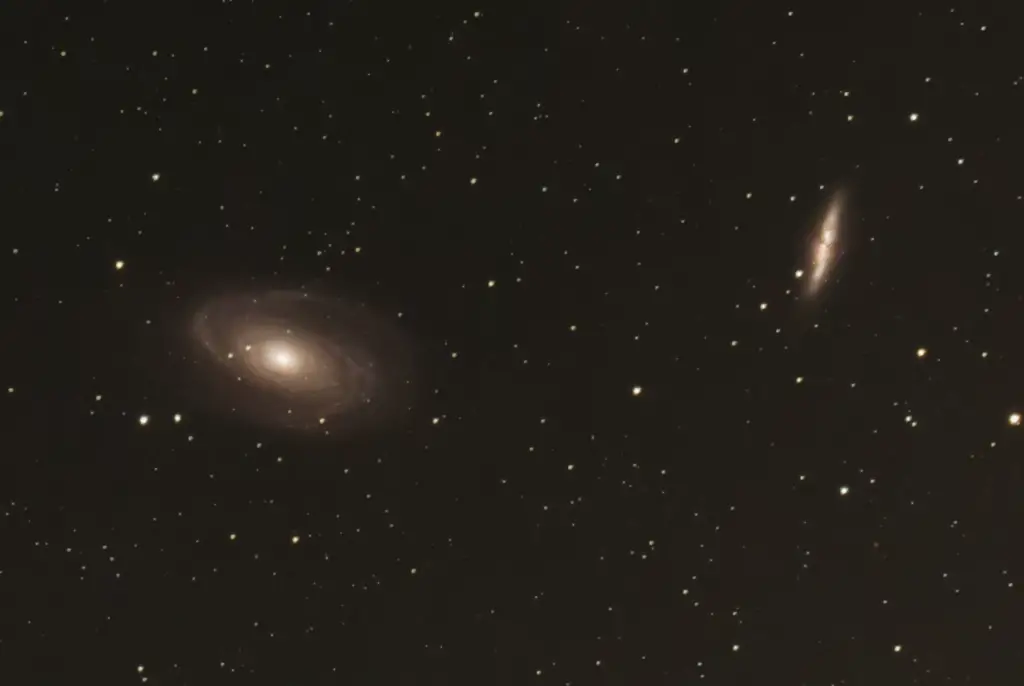
Catalogue #: M81/M82
Object type: galaxy pair
Distance: 12 million light years
Recommended equipment: telescope
What it is:
Discovered in 1774 by Johan Elert Bode, M81 is sometimes called Bode’s Nebula because in those times galaxies were called “spiral nebulae”, believed to reside within our own galaxy. Only in the last 100 years or so have we learned that the universe extends much, much further than the 100 thousand light year diameter of the Milky Way.
M81 is a spiral galaxy similar to the Milky Way in size and mass. In the same field of view we also have M82, a “starburst” galaxy where unusually active star formation causes an explosion of pink ionized gases visible in long exposures.
How to find it:
Start at the Big Dipper. Draw an imaginary line from the star at the back bottom corner of the Dipper’s bowl (Phecda) diagonally up through the star at the top front corner (Dubhe), extending this line about five degrees.
In your finderscope you should see two small, oblong patches of light side by side. It might take some scanning around as there are not many landmark stars close by.
What to expect:
Galaxies are generally the most challenging objects to observe because of the extreme distance involved. But this also makes them some of the most rewarding.
These galaxies in particular are a visual treat.
Compact and relatively bright, they both fit into the same telescopic field of view, oriented nearly at right angles to each other.
One gets the impression of narrow, slanted eyes gazing out from the blackness of space. These galaxies are also notable for their contrasting appearances: M81 is oval-shaped due to its orientation relative to Earth, with a hint of its spiral structure apparent in larger telescopes, while M82, nicknamed the Cigar Galaxy, is long, thin, and bright.
Eskimo Nebula
Catalogue #: NGC 2392
Object type: planetary nebula
Distance: 6000 light years
Recommended equipment: medium to large telescope
What it is:
NGC 2392 is a fine example of a planetary nebula, which occurs when a sunlike star has exhausted the main supply of hydrogen in its core and becomes unstable.
Gases in the star’s outer layers are blown out into a shell-like structure which then becomes ionized by ultraviolet radiation from the central star.
This process is not perfectly understood and it creates some of the most visually complex structures amongst all the deep-sky objects.
In the case of NGC 2392 this involves an inner shell surrounded by a halo of filaments radiating outward. Its appearance led to it being nicknamed the Eskimo Nebula, though perhaps Lion Nebula would be just as descriptive without the politically incorrect baggage.
How to find it:
Start by locating the constellation Gemini, notable for its two bright stars side by side. Find the star Wasat, which marks the “groin” of the Pollux twin. Star-hope eastward about 2 degrees to fifth-magnitude star 63 Gem.
From there it is not quite 1 degree southeast to the nebula. It is a very small object, less than one arc-minute in diameter, and situated next to and 8th-magnitude star. At low power it could easily be mistaken for a binary star; medium to high power is required to see its disk shape.
What to expect:
Seeing this for the first time, it’s easy to understand how such objects are called “planetary nebulae”.
Through a 4- to 6-inch telescope you will see a blue-green orb which indeed looks like a distant gas giant.
At high power with apertures over 8 inches you may detect the central star, the inner shell of gas, and even some of those outer filaments. As always, don’t expect to see photographic detail through the eyepiece.
Use averted vision, looking just beside the object instead of directly at it. Try a nebula filter if you have one, and don’t be afraid to crank up the magnification beyond what you would normally use.



